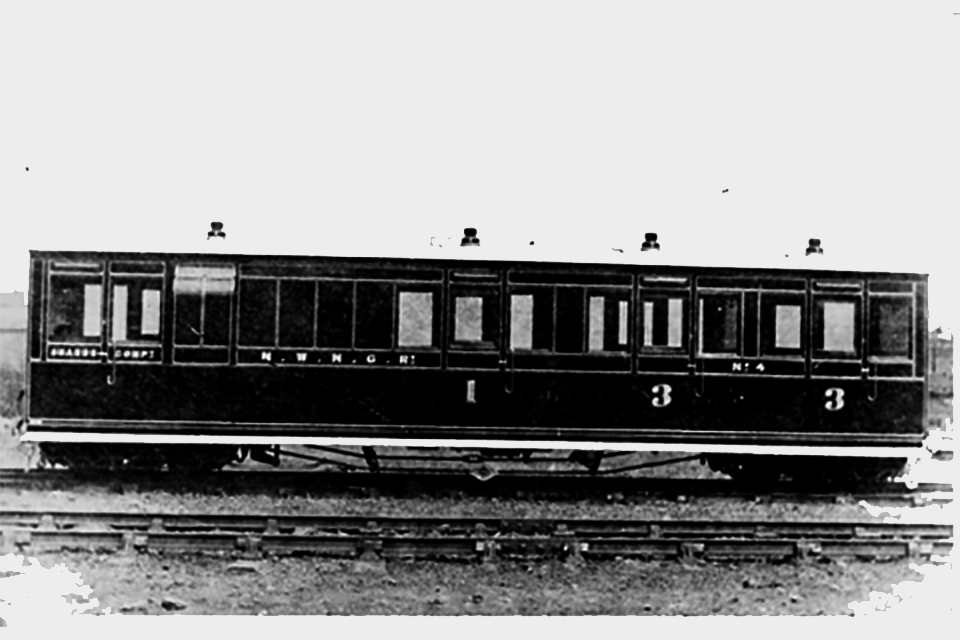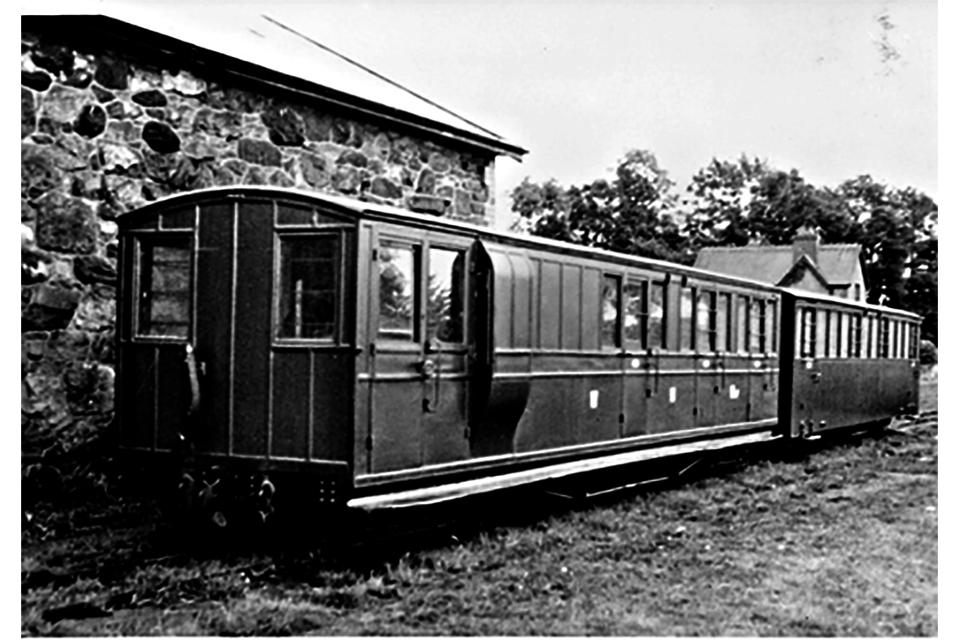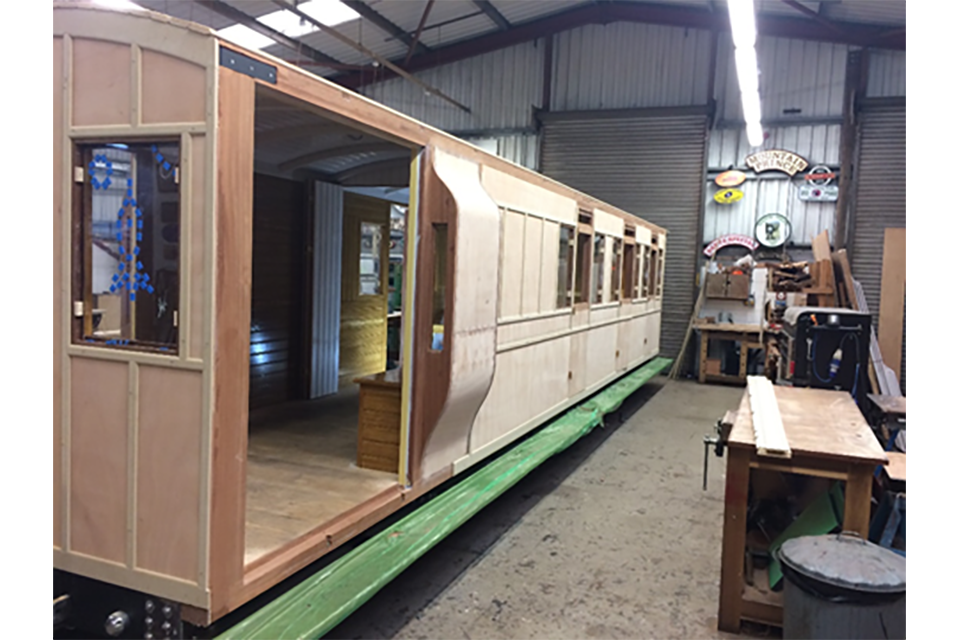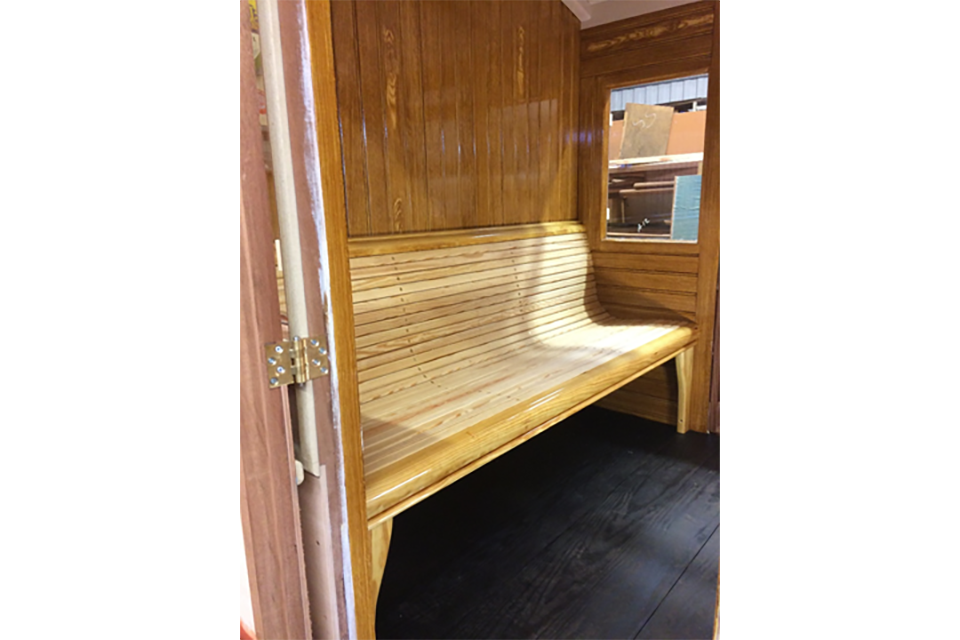Rail Vehicle Accessibility: exemption application, Welsh Highland Railway
Updated 19 April 2021
Foreword
The Rail Vehicle Accessibility (Non-Interoperable Rail System) Regulations 2010 (RVAR) set standards for the accessibility features of a rail vehicle operated on particular types of rail systems. The Secretary of State has powers under section 183 of the Equality Act 2010 to allow operators of regulated rail vehicles to continue to operate a vehicle if it does not fully comply with the standards set in the schedules to these RVAR 2010. This consultation contains the application from Welsh Highland Railway for exemption from standards set out in Schedule 1, Part 1 (General Requirements) RVAR 2010 for a newly built vehicle which recreates heritage services.
The consultation period shall run until 11 January 2021. To share your views and comments on the application please contact us at:
Rail Vehicle Access: Welsh Highland Railway
Department for Transport
Great Minster House
33 Horseferry Road
London
SW1P 4DR
Email: railvehicleaccess@dft.gov.uk
Exemption application
Replica Pickering Brake Composite Coach for the Welsh Highland Railway Limited, Welsh Highland Railway Limited (operating as the Welsh Highland Heritage Railway).
Background
This is an application for exemption from certain parts of the rail vehicle accessibility regulations for a replica of a narrow-gauge coach originally built in 1907 for operation mainly on the Welsh Highland Heritage Railway, with occasional use on the Ffestiniog and Welsh Highland Railway. The coach is currently under construction, and is expected to enter service in March 2021.
Historical context
The original Welsh Highland Railway (WHR) opened in 1923 and closed in 1937. It ran from Dinas Junction, near Caernarfon to Porthmadog. It was created by linking 2 earlier narrow-gauge railways, the North Wales Narrow Gauge Railway (NWNGR) and the Croesor Tramway. A link was also created between the Croesor Tramway and the Ffestiniog Railway at Porthmadog.
The Welsh Highland Railway was operated with locomotives and rolling stock from the North Wales Narrow Gauge Railway and the Ffestiniog Railway.
The North Wales Narrow Gauge Railway opened in 1877 and in 1907 purchased 2 brake composite coaches from R. Y. Pickering of Wishaw. The coaches had 2 third class compartments, a first-class compartment, and a guard’s compartment. The combination of classes in a single coach is referred to as a composite coach, and the addition of a guard’s compartment gives the designation brake composite. The combination of all the essential facilities in a single vehicle allowed the operation of a single coach train when traffic was low, which it often was. The coaches were a classic example of Edwardian coach building, constructed from teak and mahogany on a steel underframe.

Images showing the builders photograph of North Wales Narrow Gauge Railway Number 4
The coaches were numbered 4 and 5 by the NWNGR, and later 8 and 9 by the WHR. It is believed that they replaced older vehicles, and they appear in almost every picture of a train on the NWNGR or WHR from 1907 onwards. There is also photographic evidence of operation on the Ffestiniog Railway.
The railway was scrapped in 1941 and the rolling stock disposed of in 1942. It is not known what happened to either of these coaches after that date.

Figure 2: one of the ‘Pickering Brakes’ in later Welsh Highland Railway days. The objective is to recreate a replica that will be as close as possible to this in appearance. The other coach in the photograph has survived and been restored.
Current context and operations
The Welsh Highland Heritage Railway (WHHR) is a short narrow-gauge railway at Porthmadog. It is operated by the Welsh Highland Railway Limited. At Pen-y-mount there is a rail connection to the Ffestiniog and Welsh Highland Railway who operate the restored Welsh Highland Railway.
The replica Pickering Brake Composite will be owned by the Welsh Highland Railway Limited (WHR Ltd) and operated on the Welsh Highland Heritage Railway, with occasional operation in special heritage trains on the Ffestiniog and Welsh Highland Railway.
The WHR Ltd has 3 restored original coaches and one replica coach. These do not include either a brake coach or a wheelchair accessible coach. Our current brake van originated on another railway and our wheelchair accessible coach was built in the 1980s to a non-heritage design.
The WHR Ltd owns and operates the only surviving WHR locomotive but is currently restoring another locomotive of a type that operated on the original WHR.
The WHR Ltd’s purpose in building a replica Pickering Brake Composite Coach is to be able to operate a replica of typical Welsh Highland Railway train as ran in the 1920s and 30s. To this end the external appearance of the coach will be as close as possible to the original coach.
The Welsh Highland Heritage Railway operates a seasonal service, generally from Easter to October. Normal services operate during the day and therefore during the hours of daylight. The Railway is promoted to visitors as an experience, and to this end the guard’s duties include welcoming passengers and assisting them to board and alight.
Accessible compartment
The design of the coach, and in particular the double doors into the guard’s compartment provide an opportunity to provide for wheelchair users without compromising on the external appearance. The first-class compartment will therefore be replaced by a compartment that will be accessible to wheelchair users and provide two spaces in accordance with clause 20(1) of the regulations.
Access to the accessible compartment will be through the guard’s compartment. The partition between the guard’s compartment and the accessible compartment will be replaced with a pair of bi-fold doors. When closed these will be fixed top and bottom to provide the restraint required by clause 20(4) of the regulations. As the overall internal width of the coach is 1.67 metres the width of each pair of doors will be less than 850 millimetres (mm) but greater than 750mm.

Figure 3: the coach under construction showing the access through the guard’s compartment to the wheelchair accessible compartment, with the folding doors open. The guards compartment has external double doors with a clear opening in excess of 1.1m. The internal fittings of the guard’s compartment will be arranged to provide a clear 850mm wide route from the external doors to the accessible compartment.

Figure 4: the coach under construction, showing the doorway into the guard’s compartment, with doors yet to be fitted.
A folding ramp will be carried in the guard’s compartment and deployed by the guard to give access between the platform and the coach.
As the accessible compartment is immediately adjacent to the guard’s compartment a disabled person in a wheelchair will be able to communicate directly with the guard in an emergency through the folding doors, and thus meet the requirements of clause 20(5).
The Welsh Highland Heritage Railway currently provides accommodation for wheelchair users in a coach designed and built in the 1980’s. This coach is not an original coach nor a replica of an original, and is not therefore used in recreating heritage services.
Assessment of compliance
The rail vehicle accessibility regulations have been considered in developing the design and specification of the coach. The physical constraints of a narrow-gauge coach and the overall objective of recreating a historic vehicle, particularly in external appearance, prevent some aspects of the regulations from being met.
In order to prepare this application an assessment of the planned coach in relation to the regulations has been carried out. This assessment had identified the parts of the regulations with which the coach complies, those which are considered not applicable, and those for which an exemption is sought. More details of the latter together with the reasons and proposed mitigation are set out below.
Assessment of compliance and applicability of RVAR Schedule 1
Part 1
Subsection 1:
- sub paragraph 1, assessment: complied with
- sub paragraph 2, assessment: not applicable
- sub paragraph 3, assessment: not applicable
- sub paragraph 4, assessment: not applicable
- sub paragraph 5, assessment: complied with
- sub paragraph 6, assessment: not applicable
- sub paragraph 7, assessment: complied with
Subsection 2, assessment: not applicable
Subsection 3:
- sub paragraph 1, assessment: exemption sought
- sub paragraph 2, assessment: not applicable
- sub paragraph 3, assessment: exemption sought
- sub paragraph 4, assessment: not applicable
- sub paragraph 5, assessment: exemption sought
Subsection 4, assessment: not applicable
Subsection 5, assessment: complied with
Subsection 6:
- sub paragraph 1, assessment: complied with
- sub paragraph 2, assessment: complied with
- sub paragraph 3, assessment: exemption sought
- sub paragraph 4, assessment: not applicable
- sub paragraph 5, assessment: complied with
Subsection 7, assessment: not applicable
Subsection 8:
- sub paragraph 1, assessment: complied with
- sub paragraph 2, assessment: not applicable as there is no vestibule
- sub paragraph 3, assessment: not applicable as there is no vestibule
- sub paragraph 4, assessment: not applicable as there is no vestibule
- sub paragraph 5, assessment: not applicable
- sub paragraph 6, assessment: complied with
Subsection 9, assessment: not applicable
Subsection 10:
- sub paragraph 1, assessment: exemption sought
- sub paragraph 2, assessment: not applicable
- sub paragraph 3, assessment: not applicable
- sub paragraph 4, assessment: complied with
- sub paragraph 5, assessment: not applicable
Subsection 11:
- sub paragraph 1, assessment: exemption sought
- sub paragraph 2, assessment: exemption sought
- sub paragraph 3, assessment: not applicable
- sub paragraph 4, assessment: not applicable
- sub paragraph 5, assessment: exemption sought
- sub paragraph 6, assessment: exemption sought
- sub paragraph 7, assessment: not applicable if an exemption to 11(1) is granted
- sub paragraph 8, assessment: exemption sought
- sub paragraph 9, assessment: not applicable
- sub paragraph 10, assessment: exemption sought
- sub paragraph 11, assessment: not applicable
- sub paragraph 12, assessment: exemption sought
- sub paragraph 13, assessment: not applicable
- sub paragraph 14, assessment: not applicable
- sub paragraph 15, assessment: not applicable
Subsection 12, assessment: not applicable
Subsection 13:
- sub paragraph 1, assessment: exemption sought
- sub paragraph 2, assessment: not applicable
- sub paragraph 3, assessment: complied with
- sub paragraph 4, assessment: not applicable
- sub paragraph 5, assessment: not applicable
- sub paragraph 6, assessment: exemption sought
- sub paragraph 7, assessment: not applicable
Subsection 14:
- sub paragraph 1 (a), assessment: complied with
- sub paragraph 1 (b), assessment: complied with
- sub paragraph 1 (c), assessment: complied with
- sub paragraph 1 (d), assessment: not applicable
- sub paragraph 1 (e), assessment: exemption sought
- sub paragraph 1 (f), assessment: not applicable
- sub paragraph 1 (g), assessment: not applicable
- sub paragraph 1 (h), assessment: not applicable
- sub paragraph 2, assessment: not applicable
- sub paragraph 3, assessment: not applicable
- sub paragraph 4, assessment: not applicable
- sub paragraph 5, assessment: not applicable
Subsection 15, assessment: not applicable
Subsection 16, assessment: not applicable
Subsection 17, assessment: not applicable
Subsection 18, assessment: complied with
Subsection 19, assessment: complied with
Subsection 20, assessment: complied with
Subsection 21, assessment: not applicable
Part 2
Subsection 1, assessment: not applicable
Subsection 2, assessment: not applicable
Subsection 3, assessment: exemption sought
Subsection 4, assessment: not applicable
Subsection 5, assessment: complied with
Subsection 6, assessment: not applicable
Subsection 7, assessment: complied with
Exemptions sought
Part 1
3(1) Providing external doors with an exterior contrast and 3(3) and 3(5) Providing an audible warning device when doors are opening and closing
Reason for exemption
Providing a contrasting colour to the doors would be incompatible with the objective of creating a coach that replicates the appearance of an original vehicle and that an audible device is not necessary given the manual operation of the doors.
Mitigation
The doors will be opened and closed manually. The guard’s duties include opening and closing the doors for passengers if required. The guard physically checks that all doors are properly closed by walking the length of the train checking handles before giving the signal to the driver to start the train.
6(3) Provision of an exterior sign indicating a wheelchair compatible doorway
Reason for exemption
The provision of an exterior sign would not be compatible with the objective of creating a coach that replicates the appearance of an original vehicle. The external appearance will be as figure 2.
Mitigation
The guard’s duties include welcoming passengers to the railway and the guard will therefore be available to assist passengers who are wheelchair users. The guard will open the double doors and deploy the ramp
10(1) Provision of interior handrails at either side of doors
Reason for exemption
The coach has 3 passenger compartments with passenger seating immediately adjacent to doors, interior handrails would obstruct access to the seats and reduce the already narrow width of the coach.

Figure 5: the coach under construction, showing bench seat in third class compartment from the doorway.
Mitigation
The coach has external handrails at each doorway.
11(1) Provision of a public address system for audible and visual announcements, 11(2) Provision of exterior visual announcements, 11(5) announcement of destination, 11(6), announcement of next station, 11(8), display dimensions, 11(10) display visibility ,and 11(12) letter contrast and dimensions
Reason for exemption
The WHRLtd does not have a public address system on its existing rolling stock. Exterior visual announcements would not be compatible with the objective of creating a coach that replicates the appearance of the original vehicle.
Mitigation
The WHHR only has 2 terminal stations and an intermediate halt. The Guard passes along the platform at each stop, announcing the stop and assisting passengers to alight. The Guard also checks tickets of passengers boarding the train. This would deliver the information required by 11(5) and 11(6). Station nameboards ‘running in boards’ are provided at each station which can easily be read from the train as the train travels slowly
13(1) Designation of 10% of seats as priority and 13 (6) Provision of signs indicating priority
Reason for exemption
The coach has 3 compartments, with bench type seating. As the coach is narrow each bench seat will normally be used by no more than three adults. The seat spaces are therefore adjacent to doorways, unlike modern saloon coaches where there is a need to designate the seats adjacent to doors for disabled people this need does not arise. All seats are closer to doorways than the priority seats on a modern saloon coach as in figure 5.
Mitigation
The seats meet the dimensions set in schedule 2 C1 and C2, except that as bench seats they do not have a defined width. The guard’s duties include helping passengers find available seats and assisting them to board.
14(1)(e) Each step must be illuminated by a light placed within or immediately adjacent to the step
Reason for exemption
As a heritage railway trains normally operate during the hours of daylight, rendering such light fittings superfluous. External light fittings would also be incompatible with the objective of creating a coach that replicates the appearance of the original vehicle.
Mitigation
On occasions where trains are operated after dark, such as Halloween and Christmas specials, platforms are lit and additional staff are deployed to guide and assist passengers.
Part 2 (3) At a passenger doorway in the side of a rail vehicle the edge of the floor along the entrance must be illuminated by a light placed within or immediately adjacent to that edge
Reason for exemption
As a heritage railway trains normally operate during the hours of daylight rendering such light fittings superfluous.
Mitigation
The doorways have polished brass thresholds which are highly reflective and provide a clear indication of the floor edge. On occasions where trains are operated after dark, such as Halloween and Christmas specials, platforms are lit and additional staff are deployed to guide and assist passengers.
Summary
The purpose in constructing this coach is to recreate a typical train as would have been operated on the original Welsh Highland Railway in the 1920s and 1930s. The Welsh Highland Railway Limited has restored original coaches, and an original locomotive. The provision of this coach will allow a complete Welsh Highland train to be operated.
The layout of the coach allows provision to be made for a wheelchair accessible compartment within a replica heritage train, which has not previously been possible, and will allow those with mobility impairments to fully participate in heritage train recreation.
An assessment has been made of the regulations and their applicability to the coach. The majority of the regulations are not applicable. The remaining requirements have been complied with, but exemption is sought from clauses, which are either incompatible with, or inappropriate with, the creation of a replica to operate on a heritage railway. In each case mitigation will be provided.
Document prepared by:
R.D. Menzies.
Project Manager
Document Approved By:
N. Pell
Engineering Co-ordinator
26th November 2020
